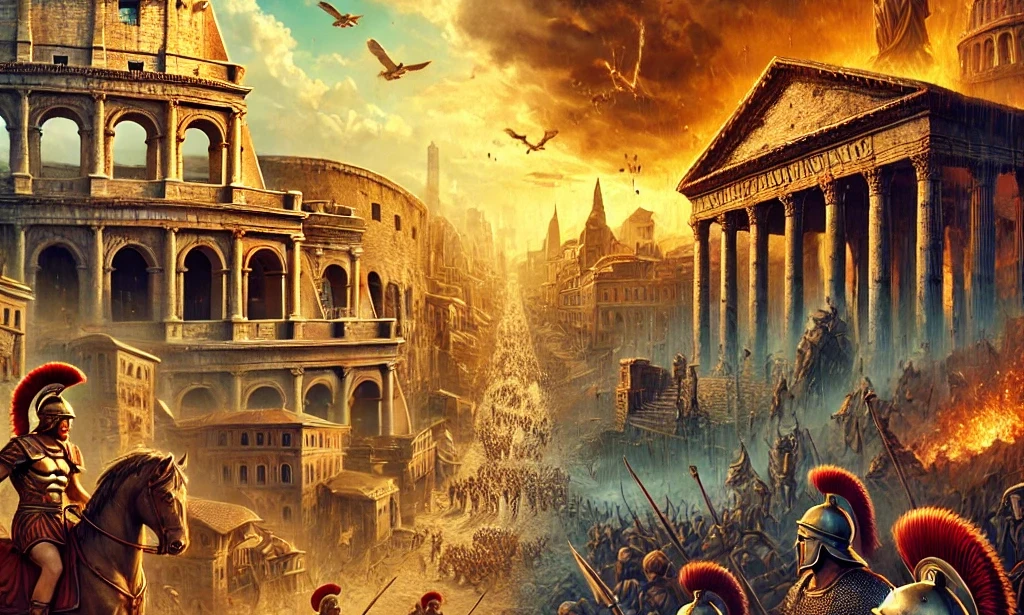The Rise and Fall of the Roman Empire: A Detailed History
Introduction
The Roman Empire remains one of the most influential civilizations in world history. Lasting from 27 BCE to 476 CE in the West (and until 1453 CE in the East as the Byzantine Empire), Rome shaped modern governance, law, architecture, and culture. This article explores the empire’s rise, peak, decline, and eventual fall, highlighting key events and figures that defined its legacy.
1. The Origins of Rome (753 BCE – 509 BCE)
Legendary Beginnings
According to Roman mythology, Rome was founded in 753 BCE by Romulus and Remus, twin brothers raised by a she-wolf. Romulus later killed Remus and became the first king of Rome.
The Roman Kingdom
Rome initially functioned as a monarchy, ruled by kings. Over time, power struggles led to the overthrow of the monarchy in 509 BCE, marking the beginning of the Roman Republic.
2. The Roman Republic (509 BCE – 27 BCE)
Establishment of the Republic
The Roman Republic replaced the monarchy with a system led by elected officials, including:
- Consuls – Two leaders who governed for one-year terms.
- Senate – A body of wealthy landowners who advised on policies.
- Assemblies – Represented the common people (plebeians).
Expansion and Conquests
Rome expanded aggressively, conquering:
- Italy (by 270 BCE) – Defeating Etruscans, Samnites, and Greek city-states.
- The Punic Wars (264–146 BCE) – Rome’s wars with Carthage, including Hannibal’s famous invasion.
- Greece and the Eastern Mediterranean (2nd century BCE) – Rome became the dominant power in the region.
Political and Social Struggles
As Rome grew, social inequality led to internal conflicts:
- The Gracchi Reforms (2nd century BCE) – Tiberius and Gaius Gracchus attempted land reforms but were assassinated.
- Civil Wars (1st century BCE) – Rival generals like Marius, Sulla, and Julius Caesar fought for power.
The Rise of Julius Caesar
Julius Caesar, a brilliant military leader, conquered Gaul (modern France) and gained immense popularity. He crossed the Rubicon River in 49 BCE, starting a civil war. After defeating Pompey, he declared himself dictator for life but was assassinated in 44 BCE.
His death led to another power struggle, eventually resulting in the rise of his adopted heir, Octavian (Augustus).
3. The Roman Empire (27 BCE – 476 CE)
The Age of Augustus (27 BCE – 14 CE)
Octavian, later known as Augustus, became Rome’s first emperor. His reign marked the start of the Pax Romana (Roman Peace), a 200-year period of stability. Key achievements included:
- Strengthening the economy and military.
- Expanding Rome’s borders to Britain, Egypt, and Germany.
- Establishing efficient governance and infrastructure (roads, aqueducts, postal systems).
The Height of the Empire (1st – 2nd Century CE)
Under emperors like Trajan, Hadrian, and Marcus Aurelius, Rome reached its peak.
- Trajan (98–117 CE) – Expanded the empire to its largest size.
- Hadrian (117–138 CE) – Built Hadrian’s Wall in Britain.
- Marcus Aurelius (161–180 CE) – A philosopher-king known for his wisdom.
Cultural and Technological Achievements
- Architecture: The Colosseum, Pantheon, and aqueducts.
- Law: Roman law influenced modern legal systems.
- Language: Latin evolved into French, Spanish, Italian, and other Romance languages.
4. The Decline of Rome (3rd – 5th Century CE)
Internal Problems
- Economic Crisis – Heavy taxation, inflation, and reliance on slave labor weakened the economy.
- Political Instability – Frequent assassinations and corruption led to weak leadership.
- Military Decline – Rome relied on mercenaries who were less loyal.
External Threats
- Barbarian Invasions – Germanic tribes like the Visigoths and Vandals attacked Rome.
- The Division of the Empire (285 CE) – Emperor Diocletian split Rome into the Eastern and Western Empires to improve governance.
- The Sack of Rome (410 CE) – The Visigoths, led by Alaric, sacked Rome.
The Fall of the Western Roman Empire (476 CE)
The final blow came when the Germanic leader Odoacer overthrew the last Roman emperor, Romulus Augustulus, in 476 CE. This event marks the official fall of the Western Roman Empire.
5. The Eastern Roman Empire (Byzantine Empire)
While the Western Empire fell, the Eastern Roman Empire (Byzantine Empire) continued for nearly 1,000 years.
- Capital: Constantinople (modern-day Istanbul).
- Notable Emperor: Justinian I (527–565 CE), who codified Roman law (Justinian Code).
- Fall of Byzantium: The empire fell to the Ottoman Turks in 1453 CE.
Conclusion
The Roman Empire’s rise and fall remain one of history’s greatest lessons on power, governance, and resilience. Its influence continues in modern law, architecture, and language. While the Western Empire collapsed, its legacy lived on through the Byzantine Empire and European civilizations.
Understanding Rome’s history helps us appreciate the complexities of empire-building and the challenges of maintaining power. Whether through military strength, political reforms, or cultural advancements, Rome shaped the world in ways that still resonate today.

Fantastic
Nice
Nice 1
You must be logged in to post a comment.